Configuring a Printer | |||
| |||
Select Tools > Options... > General > Printers.
In the Printer List area, right-click the printer to be configured then select Configure (or double-click the printer name):
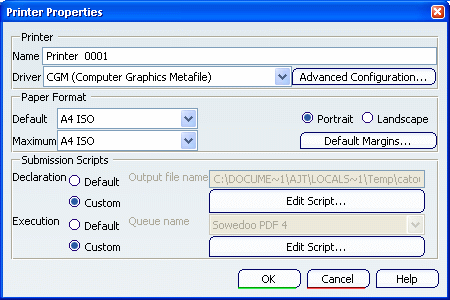
The capture above takes a 3D PLM Printer as an example. If you add a Windows printer, the properties dialog box displays standard setup parameters corresponding to the selected printer type. See your Windows documentation for detailed information about this dialog box.
In the Printer Properties dialog box, modify the necessary data.
See Adding a Printer for more information about printer properties.
Click Advanced Configuration... to configure the CGM driver:
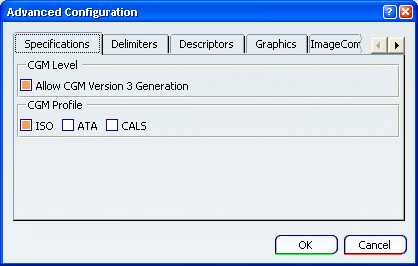
In the Advanced Configuration dialog box, access the Specifications tab then select the appropriate options:
- Allow CGM Version 3 Generation lets you generate CGM Version 3.
- ISO: CGM is a graphic format defined by the International Standards Organization ISO/IEC 8632:19999.
- ATA (Air Transport Association): part of the ATA Specification 2100. GREXCHANGE, for technical documentation of the manufacture and operation of commercial airplanes, supports the binary and clear text encodings at the CGM Version 3 functionality level. It is appropriate for the exchange of technical manuals, publishing applications, and visualization. IGEXCHANGE provides for the transfer of intelligence associated with graphical data. This profiles supports the application structuring defined in CGM Amendment 2. Both profiles are developed and maintained by the ATA/AIA (Airline Transport Association and Airline Industry Association)
- CALS (Continuous Acquisition and Life-Cycle Support): part of the CALS family of standards which is an initiative of the U.S. Department of Defense for technical illustrations and publications. This profile supports the binary encoding at the CGM Version 3 functionality level.
Access the Delimiters tab then define the necessary parameters:
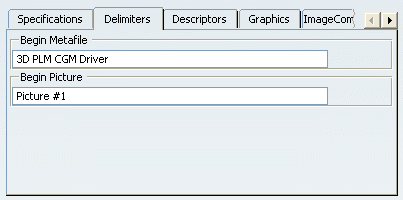
- Begin Metafile: all CGM files start with the same identifier, BEGIN METAFILE, and you can enter the data to be used as identifier. The default is "3D PLM CGM Driver".
- Begin Picture: sets the default state the CGM interpreter will return to at the beginning of each new picture. The default is "Picture #1".
Access the Descriptors tab then select the appropriate options:
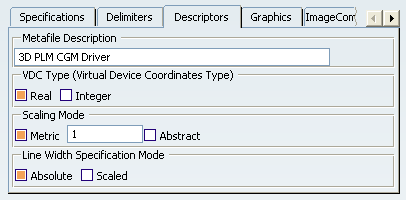
- Metafile Description: enter the description text to be used for the metafile (e.g. author, date, version, etc.).
- VDC Type: Specify the type of coordinates for the metafile, either Real or Integer.
- Scaling Mode: select the mode to be used by activating the
corresponding option.
- Metric: lets you enter the physical size of the CGMs in millimeters.
- Abstract: CGMs are dimensionless (they do not have an actual physical size you can measure in pixels, inches, etc.). In that case, Virtual Device Coordinates (VDC) are used as units of measure.
- Line Width Specification Mode.
- Absolute: the line width is measured in VDC units.
- Scaled: the line width on the printer is automatically scaled to the screen line width set as a scale factor to be applied to a device-dependent nominal line width.
Access the Graphics tab:
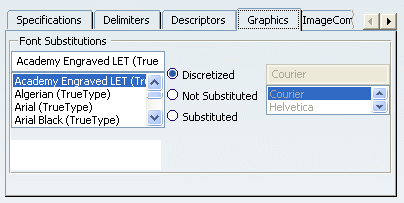
In the Font Substitutions list, select a font then set the property of your choice by selecting the appropriate option:
- Discretized: when the image suffers from a lack of points, points are distributed to fill the gaps and ensure linearity.
- Not Substituted: the font is kept as is, it is not replaced by any font.
- Substituted: lets you replace the selected font by a suitable replacement font you select in the list displayed to the right of the options. This list is activated as soon as the Substituted option is selected.
Important: You need to define this property for each font used in the document to be printed. Access the Image Compression tab then select the appropriate options:
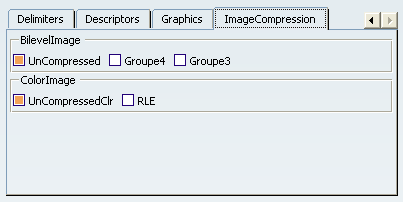
BilevelImage refers to black and white image. ColorImage refers to 3 RGB components color images. For more information about Image Compression, see Infrastructure Tools > About Capturing Images.
Click OK to validate and close the Advanced Configuration dialog box.
Click OK to close the Printer Properties dialog box.
The printer configuration file ($HOME/CATSettings/Printers/PLOTxxxx.xml) is modified.
Tip: When printing to a 3DPLM printer, the default location for the configuration file (containing the configuration settings for the driver and the printer) can be modified in the Driver Configuration Path area. Access the printer configuration file then open it:
Your modifications have been written in XML format in the file. Note that a .dtd file containing the description of the XML configuration file is provided in:
C:\Program Files\Dassault Systemes\Bn\intel_a\resources\printerDTD\printer.dtd
where "n" is the current release number and "OS_a" is your operating system (e.g. aix_a, hpux_b).
Re-select the advanced configuration settings to check that your modifications have been taken into account.